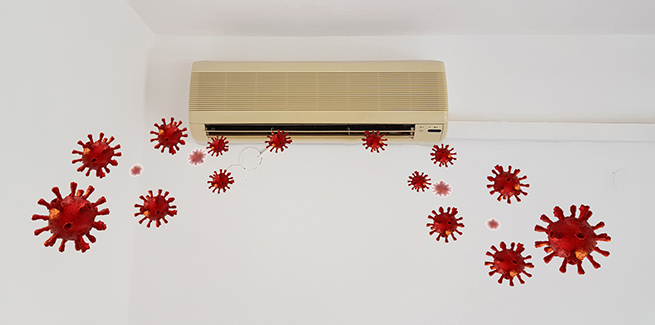COVID can spread through aerosols: The CDC changes its mind . . . again

In July, a growing number of scientists began to question the US Centers for Disease Control and Prevention (CDC) guidance that COVID-19 is spread primarily through close contact from person to person via respiratory droplets sprayed into the air when people sneeze, cough, talk, or sing.
Those scientists advocated for the possibility that those droplets could linger in the air much longer than previously suspected in the form of aerosols, which are droplets smaller than five microns (a micron is equal to one-millionth of a meter). If so, they argued, virus particles that float in the air can get sucked into ventilation systems, where they can be recirculated through heating, ventilation, and air conditioning (HVAC) systems and theoretically contaminate whole buildings.
At the time, the CDC declined to change its position.
But on Friday, September 18, the CDC updated its website to say that “small particles, such as those in aerosols,” were a common vector. The following Monday, the agency abruptly deleted the update, saying it was posted in error.
This Monday (October 5), the CDC updated their guidance again to acknowledge that “COVID-19 can sometimes be spread by airborne transmission,” especially in enclosed spaces with poor ventilation, when people are more than six feet apart.
In other words, through aerosols.
When the debate about aerosols first came up in the summer, NEWStat spoke with Carrie Pepperdine, a mechanical engineer with 20/20 Engineering in Louisville, Colorado, where she designs HVAC and plumbing systems for veterinary hospitals.
At the time, Pepperdine said that most animal hospitals already have decent HVAC systems due to concerns about containing smells and other airborne pathogens that come with the practice of veterinary healthcare. So, whichever way the science on aerosols and COVID ended up pointing, existing hospitals are probably in a good position to handle it.
Given the updated CDC guidelines, NEWStat checked in with Pepperdine again.
“It surprised me that [the CDC] changed their position,” Pepperdine told NEWStat, but added that she’s “glad” the agency made the announcement, saying she thought the CDC needed to clarify their position on aerosols being a vector, given that most research indicates that the virus is aerosolized. “All of my work is based on that being the assumption.”
Pepperdine said that’s because 20/20 Engineering follows the recommendations of the American Society of Heating, Refrigeration, and Air Conditioning Engineers (ASHRAE): “ASHRAE’S recommendations [on COVID safety protocols] have always been based on the possibility of the virus passing through HVAC systems.”
She said that’s why she’s still recommending that hospitals concerned about aerosols consider installing higher-efficiency filtration, venting air to the outside, and the possibility of ultraviolet sanitation. “As far as the way we’re doing business, [the CDC’s updated guidance] doesn’t change anything,” she said. “All of my recommendations would still stand.”
In short, as far as aerosols go, if your hospital’s HVAC systems are up to date and well maintained, you’re probably still good.
Photo credit: © summerphotos/iStock/Getty Images Plus via Getty Images



